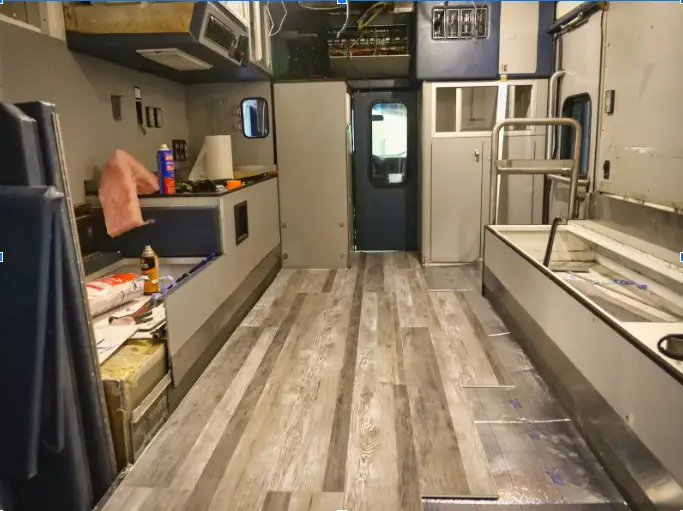Introduction
Converting an ambulance into a camper van offers a unique opportunity to create a personalized, functional mobile living space. Designing your dream ambulance camper is more than just transforming a vehicle—it’s about crafting a space that meets your needs while blending comfort, efficiency, and a touch of creativity. The interior layout plays a significant role in ensuring your new home on wheels is practical, cozy, and tailored to your lifestyle.
While some may opt for professional conversion services, many DIYers choose to take the reins on this exciting project. Whether you’re a seasoned van-lifer or new to the world of camper conversions, it’s crucial to plan the layout carefully. The goal is to create a functional space that maximizes every inch, ensuring there’s room for essential items like a bed, kitchen, and storage while keeping it visually appealing.
In this guide, we’ll explore interior design ideas that prioritize both functionality and style. From choosing the right materials to optimizing storage, we’ll break down everything you need to know about transforming your ambulance into the ultimate mobile living space.
Key Takeaways
- Space Maximization: The key to designing an effective ambulance camper is maximizing space. Opt for modular furniture, custom cabinets, and multi-functional zones to create a practical, comfortable layout.
- Material Selection: Choose durable and eco-friendly materials, such as plywood, bamboo, and foam insulation, to ensure a long-lasting, sustainable camper interior.
- Lighting and Ventilation: Proper lighting and ventilation are essential for comfort. Install LED lights, roof vents, and exhaust fans to enhance the environment and air quality inside your camper.
- Water and Plumbing Systems: Implement an efficient water system with both freshwater and greywater tanks. Choose space-saving options for your sink and shower, and consider a tankless water heater for hot water on demand.
- Safety Features: Make your camper safe with fire extinguishers, carbon monoxide detectors, and smoke alarms. Ensure your first aid kit and emergency supplies are readily accessible.
- Comfort and Personalization: Personalize your ambulance camper with custom murals, decorative accents, and functional pieces like multi-purpose furniture. Choose comfortable bedding, cushions, and flooring to enhance your living space.
- Electrical Systems: Set up an efficient electrical system with solar panels, battery banks, and inverters to provide power. Use shore power or a generator as backup for off-grid living.
Understanding the Space: How to Maximize Your Ambulance Interior
When embarking on an ambulance conversion, the first step is measuring the space and understanding its limitations. Ambulances, with their unique shape and built-in compartments, offer a decent amount of room but require thoughtful planning to ensure every inch is optimized for comfort and functionality. The key to a successful conversion lies in the layout.
Layout Options: Open-Concept vs. Multi-Room
You’ll want to decide if you prefer an open-concept layout or a multi-room design. An open layout can make your camper feel more spacious and is ideal for those who want to move freely between areas. On the other hand, a multi-room design can be great if you value privacy and the ability to separate spaces, such as a kitchen from the sleeping area.
Consider the vehicle’s dimensions to ensure the layout accommodates all essential features like a kitchenette, bathroom, and storage. Ambulances typically have a narrow width, so compact designs that maximize floor space will work best.
Creating Functional Zones
Think of your camper in terms of functional zones. Divide the space into clear areas for sleeping, cooking, and living. This zoning method helps in designing a flowing, efficient space where every item serves a purpose. Some creative examples include:
- Bedroom area: A foldable bed or Murphy bed that can be tucked away during the day.
- Kitchen zone: A countertop, induction cooktop, and sink that is compact yet fully functional.
- Storage: Consider under-bed storage, overhead shelves, and custom cabinets to make the most of vertical and horizontal space.
Space-Saving Furniture: Modular Design
Modular furniture is an excellent way to save space while maintaining comfort. Custom cabinets and multi-functional furniture allow you to adapt the space to your needs. For example, a sofa bed that easily converts into a bed is perfect for saving space while still offering comfort. Dining tables can be foldable, while shelves and custom cabinetry make the most of vertical space.
Example of Space Maximization
A great example of space maximization is using overhead storage and pull-out drawers. These storage solutions allow you to keep your camper tidy without sacrificing precious floor space. In the kitchen area, a pull-out countertop or a retractable sink can be a game-changer for people who want to maintain the option of extra space when cooking is not a priority.
Choosing the Right Materials for Your Camper Interior
When it comes to designing the interior of your ambulance camper, selecting the right materials is essential for both durability and aesthetics. The materials you choose will affect everything from comfort to maintenance and even energy efficiency. Here, we’ll explore the best materials for different areas of your camper, focusing on eco-friendly options, insulation, and long-lasting finishes.
Wood vs. Fabric: Durability and Aesthetics
Wood is a popular choice for cabinetry, flooring, and wall panels because of its durability and natural aesthetic. Materials like plywood and hardwood offer strength, while MDF (Medium Density Fiberboard) provides a smooth finish and is often used for custom-built cabinets. However, wood can be heavy, so it’s crucial to balance strength with weight when planning your design.
On the other hand, fabric can be used for upholstery on sofas, throw pillows, curtains, and bedding. Choose fabrics that are easy to clean and weather-resistant if you’re planning to travel in different climates. Water-resistant fabrics are ideal for seat cushions and throw blankets, while soft wool or cotton can add warmth and texture to your decor.
Eco-friendly Options: Sustainable Materials
If you’re passionate about sustainability, consider using eco-friendly materials throughout your ambulance camper. Bamboo, for instance, is a highly sustainable wood that can be used for floors or shelves. Cork is another excellent choice, as it is renewable, lightweight, and easy to install. For those concerned with the environmental impact, these materials offer an ethical and stylish alternative to traditional options.
Additionally, insulation plays a huge role in making your camper comfortable in both hot and cold weather. Materials like spray foam insulation, fiberglass batts, and foam boards are excellent for keeping the interior temperature regulated. Choose insulation that can be installed in tight spaces and offers high thermal resistance.
Insulation Materials: Foam, Plywood, and Metal
For a comfortable and energy-efficient camper, insulation is a must. Spray foam is a popular choice because it fills gaps and seals cracks, providing a tight seal against air leaks. Plywood can also be used to add strength to your walls and ceilings, and it can double as insulation if layered correctly. Metal, particularly aluminum, is often used for frame construction and as a protective layer for areas like the roof or underside.
The key to selecting the right insulation is understanding your climate. If you plan to travel in colder regions, opt for materials that will retain heat, such as closed-cell spray foam. For warmer climates, look for options that reflect heat and promote airflow, such as reflective foil or open-cell spray foam.
Common Finishes: Vinyl, Laminate, and Hardwood
The finish of your floors and walls sets the tone for your entire camper’s interior. Vinyl flooring is a durable and easy-to-maintain option for your living area, as it’s resistant to moisture and scratches. For a more polished look, hardwood floors can add warmth and elegance, though they may require additional care. Laminate is another affordable option that offers the appearance of hardwood without the high cost.
When choosing your wall finishes, painted plywood or laminate panels can provide a sleek, modern look. If you’re after a rustic or natural feel, wood paneling or shiplap can transform your camper into a cozy home on wheels.
Example: Custom Cabinets and Vinyl Flooring
An excellent example of how to combine durability and style is to use custom cabinets made from plywood paired with vinyl flooring. This combination ensures that your camper is stylish yet practical. The custom cabinets can be designed to fit your specific needs—whether it’s additional storage or room for your kitchen appliances.
Essential Furniture and Interior Features for Comfort and Functionality
When designing your ambulance camper, selecting the right furniture and interior features is essential for ensuring both comfort and functionality. Since space is often limited, choosing multi-functional and space-saving furniture can make a huge difference in how livable your camper is. Let’s explore the must-have furniture pieces and features that combine practicality with comfort.
Must-Have Furniture: Convertible and Multi-Functional Pieces
The key to maximizing the space in your ambulance camper is choosing furniture that serves more than one purpose. Convertible furniture is essential in small spaces, offering versatility and practicality without taking up extra room. Some furniture ideas include:
- Convertible sofa bed: A sofa that easily converts into a bed is perfect for saving space while still offering comfort.
- Murphy bed: A wall-mounted fold-down bed is a great way to keep the floor space open during the day.
- Dining table: Choose a foldable or wall-mounted table that can be stowed away when not in use.
- Bunk beds: For campers with multiple people, bunk beds can maximize sleeping space while keeping the floor clear.
Each of these pieces allows you to optimize space without sacrificing comfort. For example, a foldable dining table can double as a work surface, and a Murphy bed frees up space for other activities during the day.
By following these steps, you can transform your ambulance camper into a functional, safe, and comfortable living space that feels like home no matter where the road takes you.


